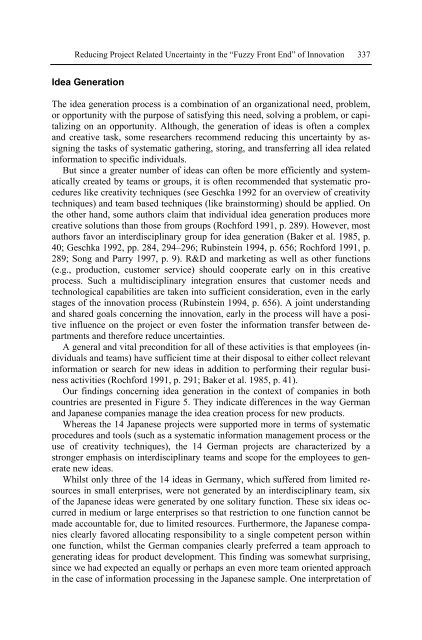Management of Technology and Innovation in Japan
Management of Technology and Innovation in Japan
Management of Technology and Innovation in Japan
You also want an ePaper? Increase the reach of your titles
YUMPU automatically turns print PDFs into web optimized ePapers that Google loves.
Reduc<strong>in</strong>g Project Related Uncerta<strong>in</strong>ty <strong>in</strong> the “Fuzzy Front End” <strong>of</strong> <strong>Innovation</strong> 337<br />
Idea Generation<br />
The idea generation process is a comb<strong>in</strong>ation <strong>of</strong> an organizational need, problem,<br />
or opportunity with the purpose <strong>of</strong> satisfy<strong>in</strong>g this need, solv<strong>in</strong>g a problem, or capitaliz<strong>in</strong>g<br />
on an opportunity. Although, the generation <strong>of</strong> ideas is <strong>of</strong>ten a complex<br />
<strong>and</strong> creative task, some researchers recommend reduc<strong>in</strong>g this uncerta<strong>in</strong>ty by assign<strong>in</strong>g<br />
the tasks <strong>of</strong> systematic gather<strong>in</strong>g, stor<strong>in</strong>g, <strong>and</strong> transferr<strong>in</strong>g all idea related<br />
<strong>in</strong>formation to specific <strong>in</strong>dividuals.<br />
But s<strong>in</strong>ce a greater number <strong>of</strong> ideas can <strong>of</strong>ten be more efficiently <strong>and</strong> systematically<br />
created by teams or groups, it is <strong>of</strong>ten recommended that systematic procedures<br />
like creativity techniques (see Geschka 1992 for an overview <strong>of</strong> creativity<br />
techniques) <strong>and</strong> team based techniques (like bra<strong>in</strong>storm<strong>in</strong>g) should be applied. On<br />
the other h<strong>and</strong>, some authors claim that <strong>in</strong>dividual idea generation produces more<br />
creative solutions than those from groups (Rochford 1991, p. 289). However, most<br />
authors favor an <strong>in</strong>terdiscipl<strong>in</strong>ary group for idea generation (Baker et al. 1985, p.<br />
40; Geschka 1992, pp. 284, 294–296; Rub<strong>in</strong>ste<strong>in</strong> 1994, p. 656; Rochford 1991, p.<br />
289; Song <strong>and</strong> Parry 1997, p. 9). R&D <strong>and</strong> market<strong>in</strong>g as well as other functions<br />
(e.g., production, customer service) should cooperate early on <strong>in</strong> this creative<br />
process. Such a multidiscipl<strong>in</strong>ary <strong>in</strong>tegration ensures that customer needs <strong>and</strong><br />
technological capabilities are taken <strong>in</strong>to sufficient consideration, even <strong>in</strong> the early<br />
stages <strong>of</strong> the <strong>in</strong>novation process (Rub<strong>in</strong>ste<strong>in</strong> 1994, p. 656). A jo<strong>in</strong>t underst<strong>and</strong><strong>in</strong>g<br />
<strong>and</strong> shared goals concern<strong>in</strong>g the <strong>in</strong>novation, early <strong>in</strong> the process will have a positive<br />
<strong>in</strong>fluence on the project or even foster the <strong>in</strong>formation transfer between departments<br />
<strong>and</strong> therefore reduce uncerta<strong>in</strong>ties.<br />
A general <strong>and</strong> vital precondition for all <strong>of</strong> these activities is that employees (<strong>in</strong>dividuals<br />
<strong>and</strong> teams) have sufficient time at their disposal to either collect relevant<br />
<strong>in</strong>formation or search for new ideas <strong>in</strong> addition to perform<strong>in</strong>g their regular bus<strong>in</strong>ess<br />
activities (Rochford 1991, p. 291; Baker et al. 1985, p. 41).<br />
Our f<strong>in</strong>d<strong>in</strong>gs concern<strong>in</strong>g idea generation <strong>in</strong> the context <strong>of</strong> companies <strong>in</strong> both<br />
countries are presented <strong>in</strong> Figure 5. They <strong>in</strong>dicate differences <strong>in</strong> the way German<br />
<strong>and</strong> <strong>Japan</strong>ese companies manage the idea creation process for new products.<br />
Whereas the 14 <strong>Japan</strong>ese projects were supported more <strong>in</strong> terms <strong>of</strong> systematic<br />
procedures <strong>and</strong> tools (such as a systematic <strong>in</strong>formation management process or the<br />
use <strong>of</strong> creativity techniques), the 14 German projects are characterized by a<br />
stronger emphasis on <strong>in</strong>terdiscipl<strong>in</strong>ary teams <strong>and</strong> scope for the employees to generate<br />
new ideas.<br />
Whilst only three <strong>of</strong> the 14 ideas <strong>in</strong> Germany, which suffered from limited resources<br />
<strong>in</strong> small enterprises, were not generated by an <strong>in</strong>terdiscipl<strong>in</strong>ary team, six<br />
<strong>of</strong> the <strong>Japan</strong>ese ideas were generated by one solitary function. These six ideas occurred<br />
<strong>in</strong> medium or large enterprises so that restriction to one function cannot be<br />
made accountable for, due to limited resources. Furthermore, the <strong>Japan</strong>ese companies<br />
clearly favored allocat<strong>in</strong>g responsibility to a s<strong>in</strong>gle competent person with<strong>in</strong><br />
one function, whilst the German companies clearly preferred a team approach to<br />
generat<strong>in</strong>g ideas for product development. This f<strong>in</strong>d<strong>in</strong>g was somewhat surpris<strong>in</strong>g,<br />
s<strong>in</strong>ce we had expected an equally or perhaps an even more team oriented approach<br />
<strong>in</strong> the case <strong>of</strong> <strong>in</strong>formation process<strong>in</strong>g <strong>in</strong> the <strong>Japan</strong>ese sample. One <strong>in</strong>terpretation <strong>of</strong>


